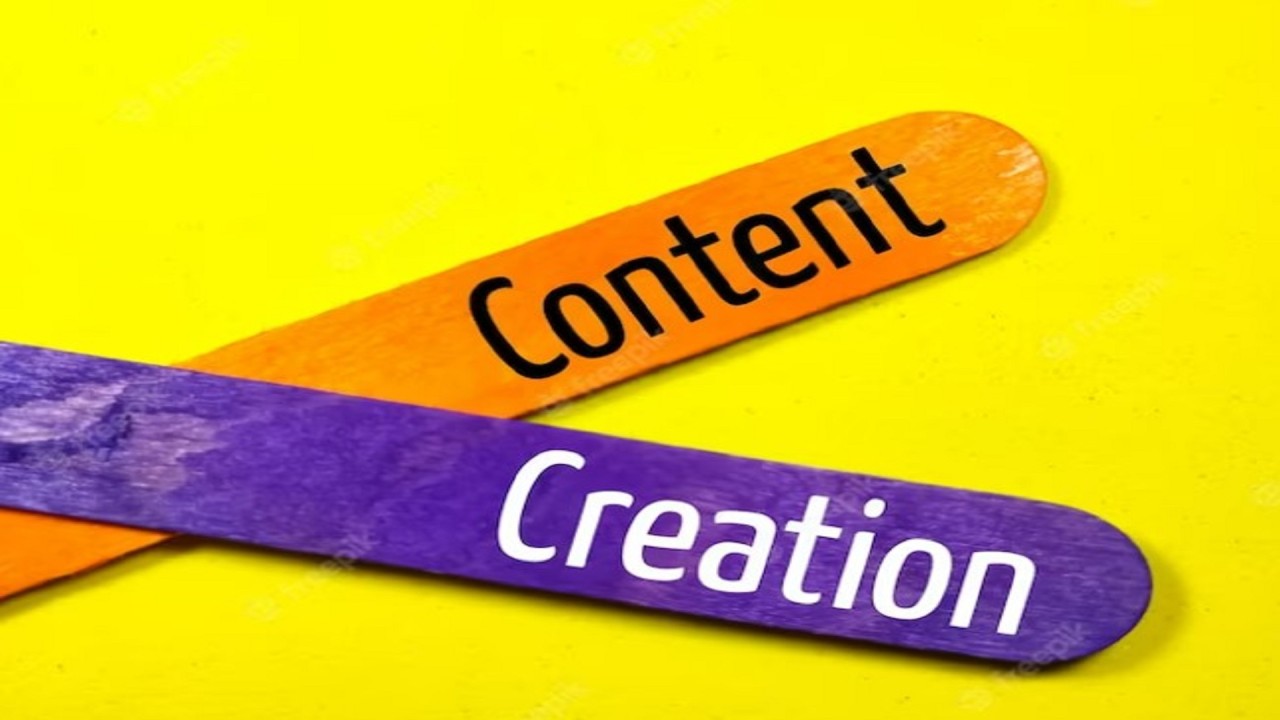"A Must Know" for Content Creators (Pt 1)
Brief Introduction to Content Creation

At its core, content creation is about crafting compelling narratives that resonate with audiences, whether through informative articles, entertaining podcasts, engaging social media posts, or immersive multimedia experiences. It's a blend of creativity and strategy, where creators harness their unique perspectives and talents to inspire, educate, and entertain.
But content creation is more than just producing material, it's a journey of exploration and discovery, a continuous process of refining ideas, honing skills, and building meaningful connections with audiences. It's about understanding the pulse of your community, anticipating their needs, and delivering value that leaves a lasting impression.
In this ever-evolving landscape, mastering the art of content creation requires adaptability, innovation, and a relentless pursuit of excellence. It's about embracing change, embracing new technologies, and pushing the boundaries of what's possible.
So whether you're a seasoned creator looking to take your craft to new heights or a newcomer eager to make your mark, content creation offers boundless opportunities for expression, growth, and impact.
Becoming an effective content creator involves a combination of creativity, strategy, consistency, and engagement. Here's a guide to help you get started:
1. Know Your Audience
 Understanding your audience is fundamental to creating content that resonates with them. Here's how to dive deeper into this crucial aspect:
Understanding your audience is fundamental to creating content that resonates with them. Here's how to dive deeper into this crucial aspect:
Start by conducting thorough research to identify who your audience is. Utilize tools like Google Analytics, social media insights, surveys, and market research to gather data on demographics, interests, behavior patterns, and preferences. Look for trends and patterns that can offer insights into their needs and motivations.
Develop detailed buyer personas that represent different segments of your audience. These personas should include information such as age, gender, occupation, interests, challenges, goals, and preferred communication channels. Having a clear understanding of your audience personas will help you tailor your content more effectively.
Engage with your audience across various channels, including social media, forums, and comment sections. Pay attention to their questions, comments, and feedback. What topics are they discussing? What problems are they trying to solve? Actively listening to your audience will provide valuable insights into their needs and preferences.
Stay abreast of industry trends, news, and conversations relevant to your audience. Use tools like Google Trends, social media monitoring tools, and industry forums to identify topics that are gaining traction. By tapping into trending topics, you can create content that is timely and relevant to your audience's interests.
Keep an eye on your competitors and analyze their content strategies. What type of content are they producing? What topics are they covering? How are they engaging with their audience? While you don't want to copy your competitors, analyzing their strategies can provide valuable insights and inspiration for your own content creation efforts.
Don't be afraid to experiment with different types of content and formats to see what resonates best with your audience. Use A/B testing and analytics to measure the performance of your content and iterate based on the results. Continuously refine your content strategy based on feedback and data to ensure that you're effectively addressing the needs and preferences of your audience.
By taking the time to truly understand your audience, you can create content that not only captures their attention but also adds value to their lives and establishes a deeper connection with them.
2. Define Your Niche
Defining your niche is about finding your unique place in the vast landscape of content creation. Here's how to delve deeper into this essential aspect:
Start by reflecting on your interests, hobbies, and areas of expertise. What topics do you find yourself constantly drawn to? What subjects do you have in-depth knowledge or experience in? Your niche should align with your passions and expertise to ensure authenticity and sustained interest.
Once you've identified potential niches, research the market demand and competition within those areas. Are there existing communities or audiences interested in your chosen niche? What gaps or opportunities exist that you can capitalize on? Conduct keyword research, explore social media conversations, and analyze competitor content to gauge the viability of your niche.
Refine your niche to be as specific and focused as possible. Rather than trying to cover broad topics, narrow down your focus to a particular aspect or subcategory within your chosen niche. For example, if your passion is fitness, you might specialize in high-intensity interval training (HIIT) workouts for busy professionals.
Think about what sets you apart from others in your niche. What unique perspective, experience, or storytelling style can you bring to the table? Your unique angle will help differentiate your content and attract a dedicated audience who resonates with your approach.
Consider the needs, challenges, and pain points of your target audience within your niche. How can your content address these needs and provide value? By understanding your audience's motivations and goals, you can tailor your content to meet their specific needs and establish yourself as a trusted resource.
As you delve deeper into your niche, remain open to evolving trends, changes in audience preferences, and emerging opportunities. Your niche may evolve over time based on your experiences, feedback, and the evolving needs of your audience. Stay flexible and adaptive to ensure long-term relevance and growth.
By defining your niche with clarity and purpose, you can position yourself as an authority in your chosen field, stand out from the crowd, and attract a dedicated audience who shares your passion and values.
3. Create Valuable Content
 Creating valuable content is about going beyond mere information dissemination; it's about delivering meaningful experiences that resonate with your audience on a deeper level. Here's how to craft content that educates, entertains, or solves problems while maintaining high quality and uniqueness:
Creating valuable content is about going beyond mere information dissemination; it's about delivering meaningful experiences that resonate with your audience on a deeper level. Here's how to craft content that educates, entertains, or solves problems while maintaining high quality and uniqueness:
Continuously strive to understand the needs, interests, and pain points of your audience. Conduct surveys, engage with them on social media, and analyze feedback to uncover the topics and issues that matter most to them.
Offer practical advice, tips, and strategies that your audience can implement in their lives or work immediately. Your content should empower your audience to take action and achieve their goals.
Storytelling is a powerful tool for engaging your audience and conveying complex ideas in a relatable way. Use anecdotes, case studies, and real-life examples to illustrate your points and connect with your audience emotionally.
Invest time and effort into creating content that is well-researched, well-written, and visually appealing. Pay attention to grammar, spelling, and formatting to ensure professionalism and credibility.
Differentiate your content by offering unique insights, opinions, or angles that set you apart from others in your niche. Don't be afraid to challenge conventional wisdom or explore unconventional ideas that spark curiosity and intrigue.
Whether you're creating blog posts, videos, podcasts, or social media content, strive to provide value to your audience at every stage of their journey. Anticipate their needs and deliver content that informs, entertains, or inspires them along the way.
Encourage interaction and dialogue with your audience by asking questions, soliciting feedback, and responding to comments. Building a sense of community around your content fosters loyalty and strengthens relationships with your audience.
Regularly evaluate the performance of your content and gather insights from analytics to identify areas for improvement. Experiment with new formats, topics, and approaches to keep your content fresh and engaging.
By consistently delivering valuable, high-quality content that addresses the needs and interests of your audience in a unique and compelling way, you can establish yourself as a trusted authority in your niche and build a loyal following over time.
4. Be Authentic
Authenticity is the cornerstone of meaningful connections in the digital world. Here's how to embrace authenticity in your content creation journey:
Start by understanding who you are, what you stand for, and what makes you unique as a content creator. Embrace your strengths, quirks, and passions, and let them shine through in your content.
Your personal experiences and journey are what make you relatable and authentic to your audience. Don't be afraid to share your successes, failures, and lessons learned along the way. Your vulnerability and authenticity will resonate with others who may be going through similar experiences.
Transparency builds trust with your audience. Share behind-the-scenes glimpses of your creative process, challenges you face, and decisions you make. Transparency fosters authenticity and fosters a deeper connection with your audience.
Stay aligned with your values and beliefs in your content creation endeavors. Don't compromise your integrity for the sake of popularity or trends. Your authenticity will shine through when you stay true to yourself.
When interacting with your audience, be genuine and sincere. Respond to comments, messages, and feedback with authenticity and empathy. Building authentic relationships with your audience fosters trust and loyalty over time.
Inject your personality into your content to make it uniquely yours. Whether you're witty, compassionate, or quirky, let your personality shine through in your writing, videos, or social media posts.
Nobody's perfect, and that's okay. Embrace imperfection and authenticity in your content creation journey. Don't be afraid to show your flaws, make mistakes, and learn from them openly. Your audience will appreciate your authenticity and humanity.
Authenticity is not a one-time effort; it's a commitment to being genuine and true to yourself in everything you do. Stay consistent in your messaging, tone, and values across all your content channels.
By embracing authenticity in your content creation journey, you can forge genuine connections with your audience, foster trust and loyalty, and make a lasting impact in the digital world.
5. Stay Consistent
Consistency is indeed crucial for maintaining audience engagement and building a loyal following. Here's how to stay consistent in your content creation efforts:
Define clear, achievable goals for your content creation endeavors. Whether it's publishing a certain number of blog posts per week, uploading videos on a regular basis, or posting daily on social media, set realistic targets that align with your resources and capacity.
Plan your content in advance by creating a content calendar. Outline the topics, formats, and publishing dates for your content to ensure a steady stream of posts. Use tools like Google Calendar, Trello, or content management systems to organize your content schedule efficiently.
Consistency is about reliability, so establish a posting schedule and stick to it. Whether you choose to post daily, weekly, or monthly, maintain a consistent frequency to keep your audience engaged and accustomed to your content.
Batch creating content can help you stay ahead of schedule and maintain consistency. Set aside dedicated time blocks to create multiple pieces of content in one sitting. This approach allows you to streamline your workflow and ensure a consistent flow of content over time.
Maximize the value of your content by repurposing it across different platforms and formats. For example, you can transform a blog post into a podcast episode, create social media graphics from key points, or compile video clips into a highlight reel. Repurposing content allows you to maintain consistency across various channels while catering to different audience preferences.
Take advantage of automation tools and scheduling features to streamline your content distribution process. Schedule posts in advance using social media management tools like Buffer, Hootsuite, or Sprout Social. Automating repetitive tasks can save time and ensure consistency in your posting schedule.
Regularly monitor the performance of your content and adjust your strategy as needed. Pay attention to engagement metrics, audience feedback, and trends to identify what's working and what's not. Adapt your content schedule and topics based on insights to keep your audience engaged and satisfied.
If you need to deviate from your regular posting schedule or take a break, communicate with your audience transparently. Let them know in advance about any changes or disruptions to your content schedule to manage expectations and maintain trust.
By staying consistent in your content creation efforts, you can build credibility, establish a strong brand presence, and cultivate a dedicated audience that looks forward to your content on a regular basis.
























































